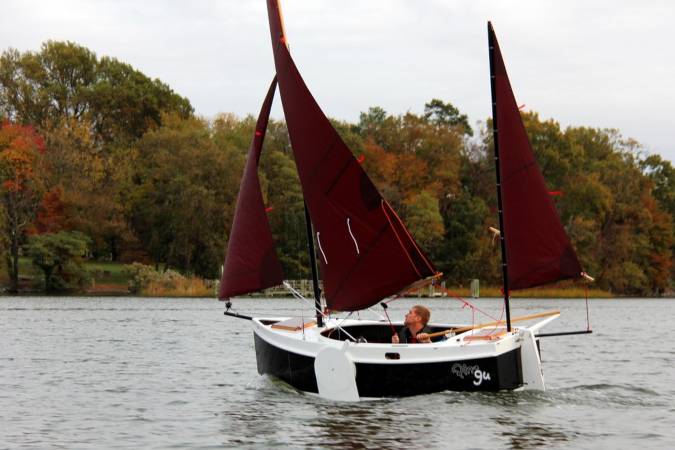






























Product Description
This tiny cruiser is intended for people who like exploring in small boats but don't have a big workshop or storage space.
The design began by calculating the smallest possible footprint for a boat that would sail and row well, allow a single person to sleep aboard in some comfort and carry a week's worth of supplies. Designer John Harris's conclusion was that a 10′ 6″ (3.2 m) hull is capable of respectable performance on all points and, in skilled hands, can manage rough coastal conditions.
I asked myself the question, ‘Just how small can we go and still have a solid camp-cruiser with good sailing and rowing qualities?’ The appeal of these tiny boats includes the low upfront cost, the magical way in which small boats make small voyages feel like big ones, and the ability between adventures to store the boat maintenance-free in the backyard or a corner of the garage.
John C. Harris, designer
The ‘nesting’ function means that the bow and stern may be unbolted and stowed in the middle section. This makes it plausible to keep the boat in an apartment, as it will just fit through a 32-inch (813 mm) doorway. It also fits in John's garden shed – not an incidental consideration.
‘It may seem odd to talk about this up front,’ says the designer, ‘but storage is a huge problem for everybody. And let's just go ahead and admit to ourselves that most sailboats sit unused for long periods of time. By shrinking beachcruiser features into the smallest practical package, we've eliminated much of the guilt you'll feel when the boat sits idle. A larger boat moulders on its trailer in the back yard while you fight the rainwater that collects in the tarp. Or the boats siphons your checking account while stored at a marina. But if your cruising boat is small enough to stand on end in a corner of your garage, the worst thing that happens is that it gets dusty.’
Real beachcruiser features are the heart of the Nesting Expedition Dinghy, starting with the cockpit. It will accommodate a 6′ 3″ (1.91 m) sailor sleeping on the floorboards. A nylon tent is easily snapped around the cockpit coaming, giving you 52″ (1.3 m) of sitting headroom. Leeboards, on unusually efficient cantilevered mounts, keep the cockpit clear of clutter. Oars have dedicated storage on deck. Large watertight compartments in the bow and stern will hold far more gear than you could ever carry in a backpack. A big-boat feature is a dedicated self-draining anchor well in the bow, so that your muddy anchor and rode never come near the cockpit.
The boat is designed to carry 45 kg of water ballast underneath the cockpit, making the boat stable when the crew shifts their weight, so that it isn't exhausting to live aboard for a few days.
The Nesting Expedition Dinghy is a beach-cruiser at heart and will be at its best when hopping from cove to cove in mostly sheltered waters. With a draught of six or seven inches, you'll be able to explore rivers and estuaries that are normally off-limits to anything larger than a kayak or canoe.
Early tests suggest the boat is a delight to sail. Deep rocker keeps the wetted surface low and improves handling in choppy conditions. The Nesting Expedition Dinghy pops right up to hull speed and is easy to keep moving. The yawl rig, featuring a furling jib, solent lug mainsail and leg o'mutton mizzen, provides numerous sail combinations to suit conditions from light airs to run-for-shelter gales. The simpler (and slightly smaller) balanced-lug rig is easier to handle and will be a good choice for windy areas.
While the Nesting Expedition Dinghy is responsive and fun to sail, John provides some perspective: ‘I imagine you could see five knots in the right conditions, but this design is meant for covering distance in comfort, not winning regattas. 30-40 mile days are the target here. 3½ or 4 knots for eight to ten hours. That doesn't seem all that fast until you compare it to what a backpacker can manage on the trail, which is half that, at best. And you can carry four times more gear in the boat than you can in a backpack.’
Construction is straightforward, especially for someone with a bit of carpentry background. The plans are detailed and easy to follow, with plywood layouts and measurements. Fibreglass sheathing is suggested for durability but isn't a requirement. The hull is built from 6 mm and 9 mm plywood with chine logs and sheer clamps. Spars are stock aluminium tubes.
Considerable weight and construction time could be saved by eliminating the nesting feature; the plans also show this option. This would also create a longer cockpit, for taller sailors.

PDF plans
This option is to download the complete plans for building the Nesting Expedition Dinghy in PDF format. The plans comprise 19 sheets sized 11″ × 17″ (280 × 432 mm). All dimensions are shown in both metric and imperial units.
Please note that there is no instruction manual for this boat. While the level of detail in these plans is very high, builders will need to be comfortable reading and working from plans.
After credit card authorisation a download link will be sent to the email address put on the order form.
PDF study plans
These study plans are intended to give you an overview of the construction of the boat. They are in PDF format that can be viewed using Adobe Reader. There are three pages and they measure 279 × 216 mm (11″ × 8½″). They can be printed for carrying around.
After credit card authorisation a download link for the study plans will be sent to the email address put on the order form.





